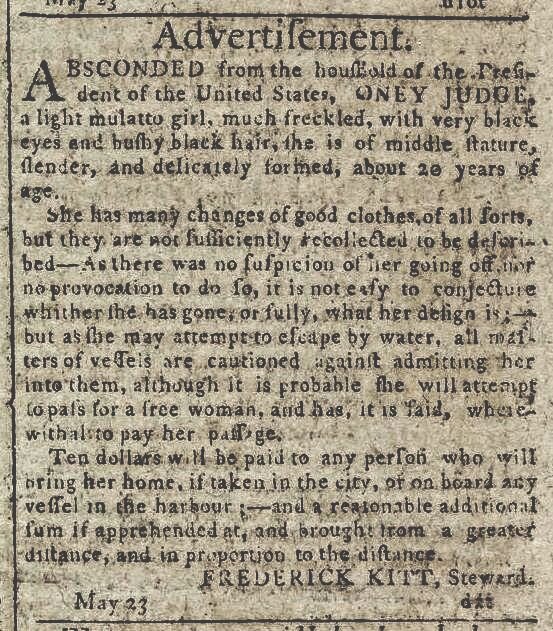Develop an attitude of ingratitude
Ungrateful women don’t get enough credit. No one ever escaped slavery with an attitude of gratitude — not Harriet Tubman, not Sojourner Truth, and certainly not Ona Maria “Oney” Judge.
Two hundred twenty-five years ago, Oney had the nerve to liberate herself from the household of George Washington. Apparently ”the ingratitude of the girl — who was brought up & treated more like a child than a servant” was a bit offensive to the first president. It’s that kind of uppity-Negress thinking that deserves a series of collages.
Oh, but it gets better. George needs Oney recaptured quietly, to “deceive… the Public.” The henchman does catch up with her — but Oney won’t go unless George agrees to free her upon his death. Remember, Oney’s making this demand while the threat of re-enslavement hangs over her head.
It’s hilarious (225 years later) to read his outraged response: “it would neither be politic or just to reward unfaithfulness.” May we all aspire to such audacity. If you can’t be a good example — to other oppressed people — at least be a dire warning to your oppressor. Check back in with me for the final collage in the Oney Judge series.
GW to US: my baby done left me
This is a story about a woman who walked out on a man without saying a word. Not even “I’m just going out for milk.”
Detail view, “Tell Her Things Will Be Different” by Lisa Myers Bulmash. Copyright of this and following artwork images belong to the artist.
The man was our first president, George Washington. The woman who left him was Ona Maria “Oney” Judge, an enslaved woman who worked as Martha Washington’s ‘lady’s maid.’ I’m obsessed with the story of this self-rescuing princess who decided she’d had enough. The best part: Oney remained free for the rest of her life.
Long story short, Washington placed ads and leaned on his contacts to help recover his “property” discreetly, but failed. I’ve incorporated images of that notice and other “runaway slave” newspaper ads in my newest collage, “Tell Her Things Will Be Different.”
The first ad George Washington placed to recapture Oney Judge. Credit: Library of Congress
The ad’s phrasing just creeps me out: “there was no suspicion of her going off, nor no provocation to do so…” It sounds like an abusive person playing dumb about why their partner left. And this was all happening while he was busy fathering a nation.
Yes, I knew Washington legally owned (more than a hundred) people; yes, I know I’m judging him by today’s standards. Must be something about the banality of evil. He might as well have been putting up flyers for a lost dog. From 2021, though, Oney’s escape looks more like a person sensibly backing away from a scorpion.
I can’t just leave the story after one collage. Two more are banging on my door trying to get out, so keep an eye out in the coming weeks for more installments of the Oney Judge saga.
Find it in the classifieds
You know how Black people sometimes (still) have to remind others that we don’t all look alike? That came to mind as I pored over colonial-era classified ads to recapture self-liberated people (“runaway slaves,” that is).
Newspapers used the same sketches over and over, like stamps; sometimes the image used was of a man, regardless of who had escaped. The accompanying text gave specifics of a person’s appearance. I used to find the image repetition degrading.
But it turns out the sameness and lack of detail makes it psychologically easier for me to work with them. It also amuses me to think of how Harriet Tubman exploited the timing of the ads’ publication. She famously launched escape missions on Saturdays if possible, to gain a head start before the ads appeared the following Monday.
Of course, there’s “more to our history than Egypt and slavery.” Artnet currently has a list of Black History Month educational resources. They provide a welcome antidote to the “they all look alike to me” mindset. As for my collage in progress, stick around for next week’s post: that’s when I’ll explain why I chose to use these classified ad sketches.











